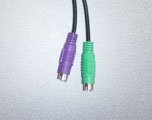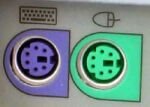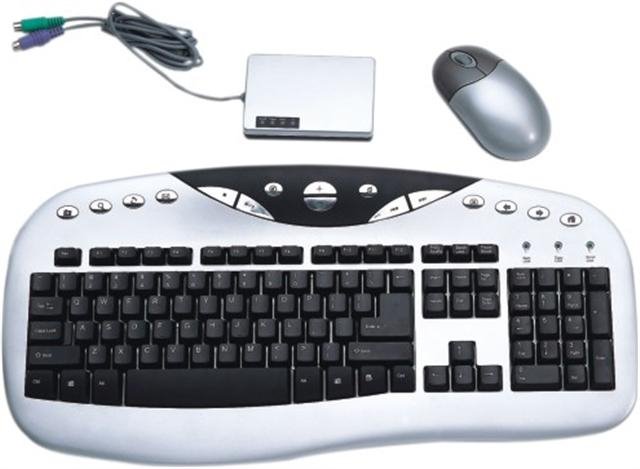There are three basic ways in which the mouse and keyboard can connect with your computer. The first and oldest way is via PS/2 connectors which were introduced by IBM in their first personal computers and were widely adopted by other manufacturers. These are 3/8" round 6-

 pin connectors that plug into corresponding sockets at the rear of the system case. Over the years a semi-informal colour coding of the connector and socket has been introduced with the mouse being colored green and the keyboard coloured violet (note that this is not universally adopted by all manufacturers and orange can be found used commonly for the keyboard). The connectors and sockets are keyed, which means that the connector will only go into the socket in one particular orientation. Trying to force the connector into the socket in the wrong orientation can lead to damaged pins, a not uncommon problem. While all older PCs and most newer ones will have PS/2 sockets fitted, some newer PCs designated as "legacy-free" do not have them. This is rarely a problem as most newer PCs can use mice and keyboards based on USB connectors. One point to note is that although PS/2 connectors for the keyboard and mouse are physically the same, if you plug them into the wrong socket at the back of your computer the machine will generally stop booting and present a "keyboard error" on the screen.
pin connectors that plug into corresponding sockets at the rear of the system case. Over the years a semi-informal colour coding of the connector and socket has been introduced with the mouse being colored green and the keyboard coloured violet (note that this is not universally adopted by all manufacturers and orange can be found used commonly for the keyboard). The connectors and sockets are keyed, which means that the connector will only go into the socket in one particular orientation. Trying to force the connector into the socket in the wrong orientation can lead to damaged pins, a not uncommon problem. While all older PCs and most newer ones will have PS/2 sockets fitted, some newer PCs designated as "legacy-free" do not have them. This is rarely a problem as most newer PCs can use mice and keyboards based on USB connectors. One point to note is that although PS/2 connectors for the keyboard and mouse are physically the same, if you plug them into the wrong socket at the back of your computer the machine will generally stop booting and present a "keyboard error" on the screen.The second way of connecting mice and keyboards to PCs is using USB connectors and sockets,

 which are present on all PCs manufactured in the last 10 years. These will be familiar to most PC users and as soon as you plug in either a keyboard or mouse it should be recognized by Windows as a "HID-compliant device" - HID standing for Human Interface Device, a grandiose way of describing a keyboard or mouse.
which are present on all PCs manufactured in the last 10 years. These will be familiar to most PC users and as soon as you plug in either a keyboard or mouse it should be recognized by Windows as a "HID-compliant device" - HID standing for Human Interface Device, a grandiose way of describing a keyboard or mouse.The final way of connecting your mouse and keyboard to your PC is wirelessly. Well, it's not truly wirelessly, as you must plug in a small wireless receiver to your PS/2 or USB port (both PS/2 and USB versions are available) and place this receiver on the desk that you are working on. Once this is done you need to pair the mouse and
 keyboard with the transmitter, normally by pressing synchronisation buttons on both units at the same time. As the mouse and keyboard are not connected directly to the computer they need a power supply to run their small wireless transmitters and this is supplied by batteries, either disposable or rechargeable. I favour rechargeable ones as you don't have the environmental issues associated with disposing of spent alkaline batteries.
keyboard with the transmitter, normally by pressing synchronisation buttons on both units at the same time. As the mouse and keyboard are not connected directly to the computer they need a power supply to run their small wireless transmitters and this is supplied by batteries, either disposable or rechargeable. I favour rechargeable ones as you don't have the environmental issues associated with disposing of spent alkaline batteries.Keyboards can now be purchased with all sorts of extra "multimedia" buttons on them that do everything from launching Google to adjusting the volume of your loudspeakers. Personally, I'm not a big fan of these, but if you find the additional features useful and you're willing to pay for them, then go for it.
When it comes to mice there are a multitude of different flavours of the same principle, all of which basically do the same job of moving the cursor around your screen. However, there is only one solid piece of advice that I would give you in relation mice. And it is this. If you still use a mouse with a ball in its base, place it in your bin, put your bin out for collection and buy an optical mouse. Optical mice have no moving parts and consequently do not jam up with fluff and detritus from your desk, resulting in jerky, stop-start movement. Get an optical mouse for around €10 and you'll never look back.
Coming next, the system case.
No comments:
Post a Comment